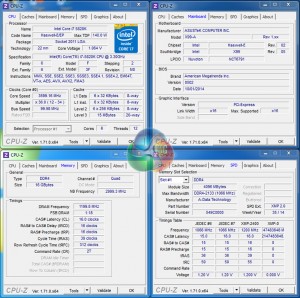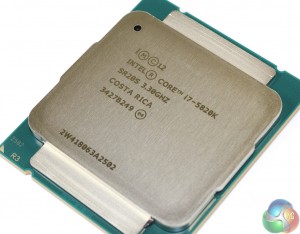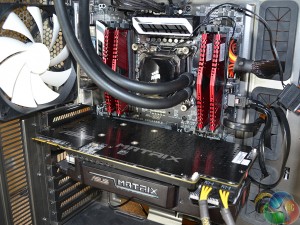Six hyper-threading cores combine with 15MB of cache and a 3.6GHz maximum clock speed for the 5820K, versus the quad-core 4790K with its 8MB cache and 4.4GHz maximum frequency. We would expect the six-core part to excel in multi-threaded workloads, but the 4790K's 0.8GHz speed advantage could keep it competitive in frequency-intensive and computationally balanced tasks.
The 5820K's battle with Intel's £760 flagship of not so long ago, the Ivy Bridge-E 4960X, will also be an interesting one. Can the proficiencies of Haswell's micro-architecture offset any performance shortages originating from the 0.4GHz frequency deficit?
As is typical for many modern motherboards, enabling XMP applies multi-core turbo (MCT) which forces a processor to continuously operate at its maximum turbo level on all cores. This 3.6GHz frequency will be displayed as the ‘stock’ setting for our i7 5820K data.
We have outlined in the past how this is perhaps not the most accurate representation of ‘stock’ performance for a processor, but all five of the 2400MHz+ DDR4 memory kits that I have tested use XMP 2.0 configurations to reach their rated speeds. By that logic, testing with MCT enabled is arguably more representative of real-world performance.
CPU-Z reports a stock (MCT) voltage level of 1.055-1.065 being delivered to the 5820K. That is a considerably lower level than the 1.20V most motherboards feed to our 5960X when MCT is taken into account. The low stock (MCT) operating voltage should translate into impressive power and temperature numbers.
Our real focus for today's comparison is between the similarly-priced Haswell-E 5820K and Devil's Canyon 4790K. Intel's current flagship – the £770 Haswell-E 5960X – also features to show what those two extra cores and 5MB of additional cache give a user. The Ivy Bridge-E 4960X is included for reference purposes.
All processors will be compared at stock (MCT) speeds and typical overclocked frequencies.
Test systems are kept as similar as possible (regarding graphics, power, and cooling), although we do choose to differentiate the two Haswell-E systems.
For the purpose of realism, we adjust the 5820K's partnering motherboard to the cost-effective Asus X99-A. Memory is also changed from a high-priced 3000MHz DDR4 kit to a set of affordable 2400MHz modules from ADATA.
Test Configuration:
| CPU |
Intel Core i7 5820K ‘Haswell-E'
(Retail) 6 cores, 12 threads |
|||
| Stock Speed |
3.6GHz (MCT)
|
3.5GHz (MCT)
|
4.0GHz (MCT)
|
4.4GHz (MCT)
|
| Motherboard |
Asus X99-A
BIOS v0502 (LGA 2011-3, X99) |
|||
| Memory |
16GB (4x4GB) ADATA XPG Z1
2400MHz 16-16-16-39 DDR4 @ 1.20V |
16GB (4x4GB) G.Skill RipjawsX
2133MHz 9-11-11-31 DDR3 @ 1.60V |
16GB (2x8GB) Corsair Vengeance Pro
2400MHz 10-12-12-31 DDR3 @ 1.65V |
|
| Overclock |
4.5GHz @ 1.275V
2400MHz CL15 DDR4 |
4.4GHz @ 1.30V
2666MHz CL16 DDR4 |
4.5GHz @ 1.425V
2000MHz CL11 DDR3 |
4.7GHz @ 1.30V
2400MHz CL10 DDR3 |
| Graphics Card |
Asus R9 280X Matrix Platinum 3GB
Catalyst 14.4 drivers |
|||
| System Drive |
Samsung 840
500GB SSD |
|||
| CPU Cooler | ||||
| Power Supply | ||||
| Operating System |
Windows 7 Professional with SP1 (64-bit)
|
|||
Tests:
- Super Pi – 32M test (CPU)
- Cinebench R15 – All-core & single-core CPU benchmark (CPU)
- HandBrake 0.9.9 – Convert 4.36GB 720P MKV to MP4 (CPU)
- SiSoft Sandra 2014 SP2 – Processor arithmetic, cryptography, memory bandwidth (CPU & Memory)
- 3DMark 1.3.708 – Fire Strike (System)
- PCMark 8 v2.0.288 – Home (System)
- WinRAR 5.10 – Built-in benchmark (System)
- Bioshock Infinite – 1920 x 1080, ultra quality (Gaming)
- Metro: Last Light – 1920 x 1080, high quality (Gaming)
- Tomb Raider – 1920 x 1080, ultimate quality (Gaming)
 KitGuru KitGuru.net – Tech News | Hardware News | Hardware Reviews | IOS | Mobile | Gaming | Graphics Cards
KitGuru KitGuru.net – Tech News | Hardware News | Hardware Reviews | IOS | Mobile | Gaming | Graphics Cards






MKV is not a video format, it is a container. What format was the video in for the conversion? Odds are it was already an MP4 encoded using H.264 which was Stored as a stream inside the MKV file – meaning your test was just resampling the original file and not really encoding anything.
You are correct. As suggested, the file uses an MPEG-4 part 10 (H.264) codec and is simply contained within the MKV container. The operation being run is more of a remuxing process than an encode – it takes the H.264 video out of a MKV container and puts it into a MP4 container.
The test results are still perfectly valid and highlight differences in processing power. I will look into a ‘true’ encode test for future usage.
Well, a couple things about video encoding you should probably take into account. 1) Your using Handbreak, which uses Gstreamer, which doesn’t natively use Intel’s Quick Sync Video – but it does Use VCE (the Radeon 280x in your test build supports VCE) 2) so while you where testing the processors ability to pass information along, you won’t actually be testing the SIP components on the Processors unless you use a program that fully utilizes the Gen2 and Gen3 Intel Quick Sync technologies in the IB-E or the Haswell.
So unless you use a program that isn’t routing directly through the video card, you won’t actually be testing the processor with video encoding.
But the issue is that QuickSync doesn’t exist on the platform LGA2011, that is part of the platform 1155/1150 as they have their GPU builtin on the die, unlike the LGA2011 counterparts.
One of the processors being compared here (the 4790k) has Intel Quick Sync. just because the 5820k doesn’t, doesn’t mean the tests used shouldn’t support it. I was also bringing up the fact that any transcoding done on this specific build will utilize the GPU’s video encoding technology and not really be a true representation of the CPU’s encoding ability.
Could somebody help me pls?
I have a sabertooth z97 mark 1 and it is supposed to run 5th gen processor (updating it), but the thing is that the socket the mother has is an 1150 and I see the 5th gen are lga 2011 or 2011-v3. Here comes my question.
After my BIOS is upgraded it’s supposed to work with the lga 2011 processors?
my i7 5820k at stock speeds idles at around 29 degrees celcius with an h100i and all case fans at max. is that ok???
That’s typical, provided the ambient temperature is in the low 20s. Mine’s currently at 4.5ghz idles around 33c with a custom loop
Denise, I imagine you’ve gotten the answer to this question by now, but the 1150 and the 2011 sockets are unfortunately physically different so a BIOS update will not let you use any of the Haswell-E CPU’s in the 1150 socket.